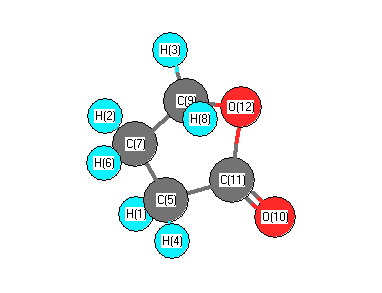Vibrational Frequencies calculated at B2PLYP=FULL/aug-cc-pVTZ
| Mode Number |
Symmetry |
Frequency
(cm-1) |
Scaled Frequency
(cm-1) |
IR Intensities
(km mol-1) |
Raman Act
(Å4/u) |
Dep P |
Dep U |
|---|
| 1 |
A |
3155 |
3027 |
7.61 |
|
|
|
| 2 |
A |
3147 |
3019 |
20.21 |
|
|
|
| 3 |
A |
3135 |
3007 |
14.43 |
|
|
|
| 4 |
A |
3084 |
2959 |
19.76 |
|
|
|
| 5 |
A |
3075 |
2950 |
5.43 |
|
|
|
| 6 |
A |
3067 |
2943 |
36.03 |
|
|
|
| 7 |
A |
1836 |
1762 |
406.24 |
|
|
|
| 8 |
A |
1544 |
1481 |
0.68 |
|
|
|
| 9 |
A |
1518 |
1456 |
5.87 |
|
|
|
| 10 |
A |
1484 |
1424 |
8.03 |
|
|
|
| 11 |
A |
1407 |
1350 |
15.05 |
|
|
|
| 12 |
A |
1358 |
1303 |
1.31 |
|
|
|
| 13 |
A |
1320 |
1267 |
6.01 |
|
|
|
| 14 |
A |
1277 |
1225 |
6.82 |
|
|
|
| 15 |
A |
1234 |
1184 |
11.15 |
|
|
|
| 16 |
A |
1212 |
1162 |
3.54 |
|
|
|
| 17 |
A |
1173 |
1125 |
210.89 |
|
|
|
| 18 |
A |
1109 |
1064 |
10.75 |
|
|
|
| 19 |
A |
1065 |
1022 |
74.03 |
|
|
|
| 20 |
A |
1016 |
975 |
24.86 |
|
|
|
| 21 |
A |
947 |
908 |
5.31 |
|
|
|
| 22 |
A |
903 |
866 |
8.70 |
|
|
|
| 23 |
A |
882 |
846 |
24.62 |
|
|
|
| 24 |
A |
810 |
778 |
5.36 |
|
|
|
| 25 |
A |
683 |
655 |
3.76 |
|
|
|
| 26 |
A |
643 |
617 |
4.46 |
|
|
|
| 27 |
A |
537 |
515 |
3.61 |
|
|
|
| 28 |
A |
490 |
470 |
3.04 |
|
|
|
| 29 |
A |
208 |
200 |
2.14 |
|
|
|
| 30 |
A |
149 |
143 |
0.88 |
|
|
|
Unscaled Zero Point Vibrational Energy (zpe) 21733.2 cm
-1
Scaled (by 0.9594) Zero Point Vibrational Energy (zpe) 20850.8 cm
-1
See section
III.C.1 List or set vibrational scaling factors
to change the scale factors used here.
See section
III.C.2
Calculate a vibrational scaling factor for a given set of molecules
to determine the least squares best scaling factor.
